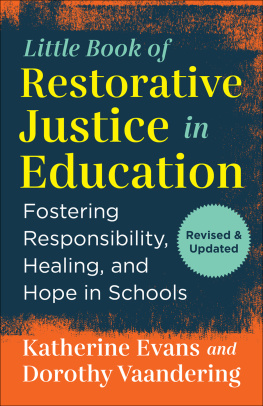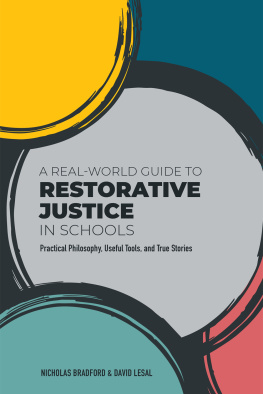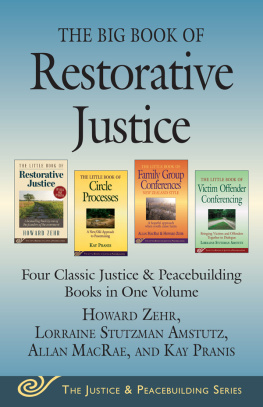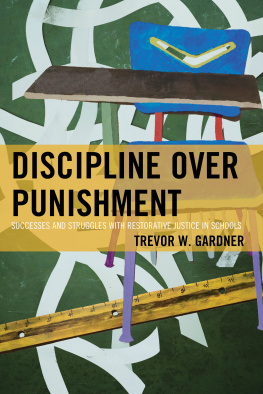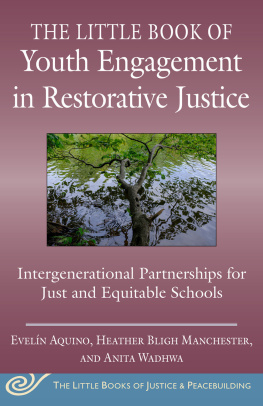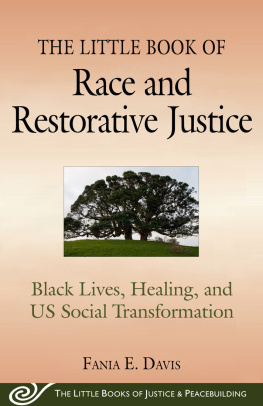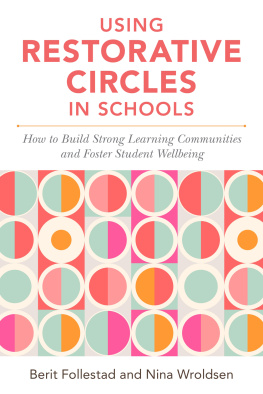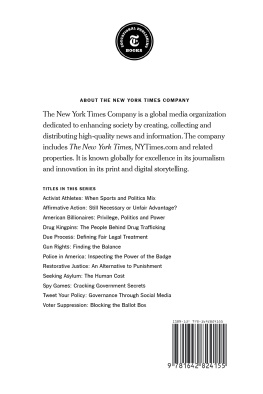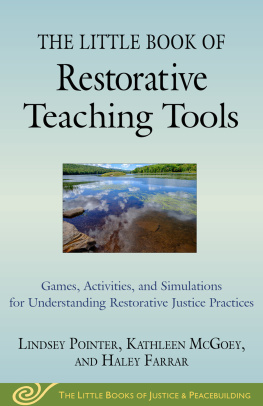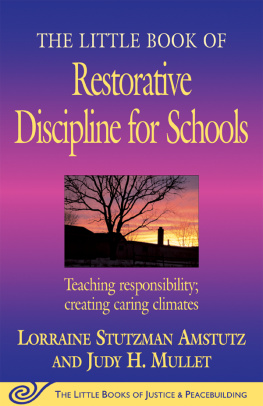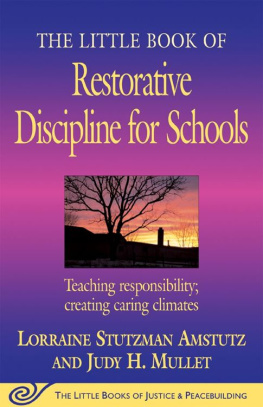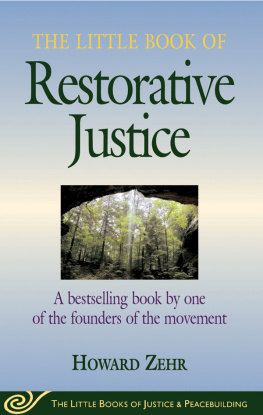
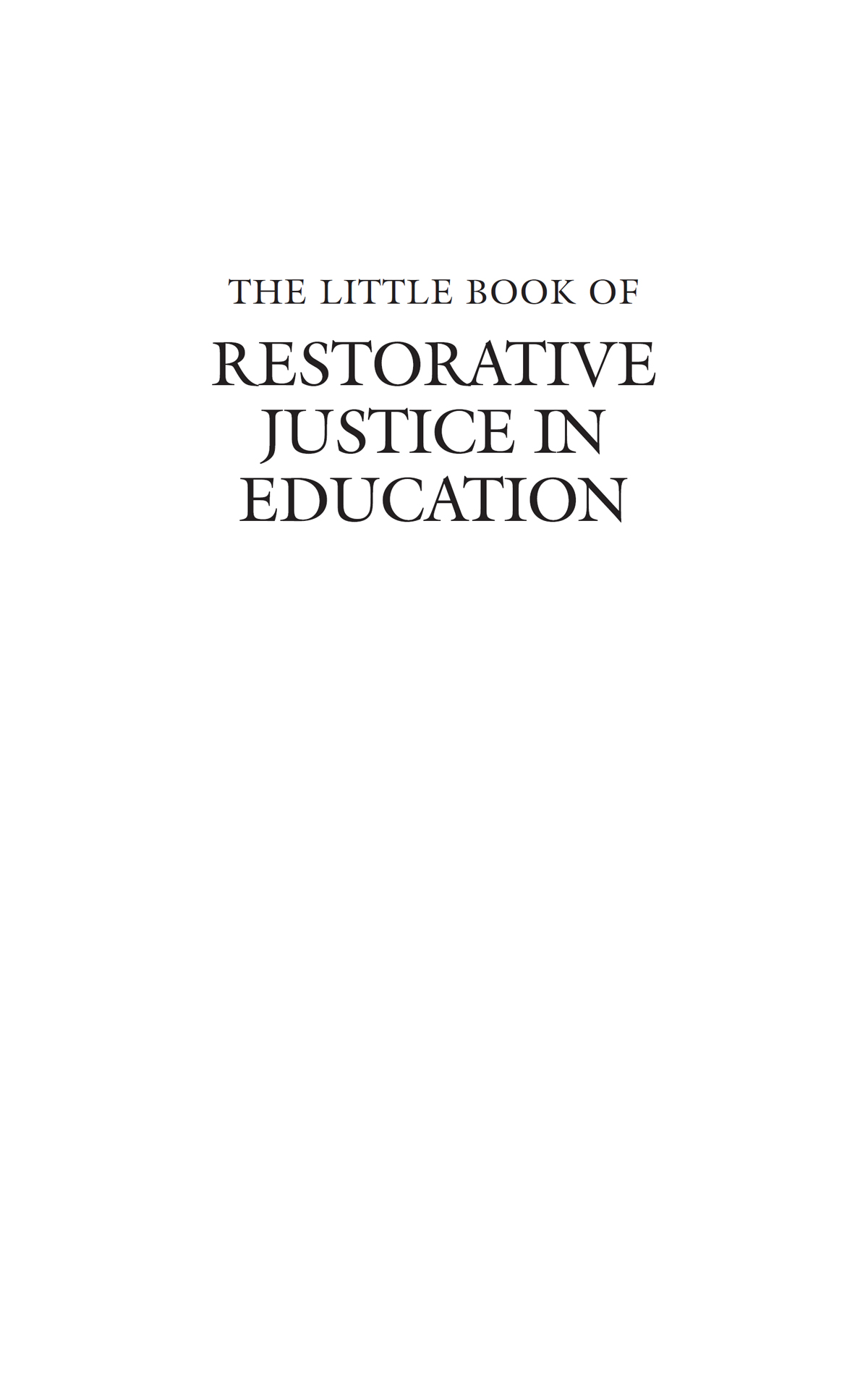

Published titles include:
The Little Book of Restorative Justice: Revised & Updated,
by Howard Zehr
The Little Book of Conflict Transformation, by John Paul Lederach
The Little Book of Family Group Conferences, New-Zealand Style, by Allan MacRae and Howard Zehr
The Little Book of Strategic Peacebuilding, by Lisa Schirch
The Little Book of Strategic Negotiation,
by Jayne Seminare Docherty
The Little Book of Circle Processes, by Kay Pranis
The Little Book of Contemplative Photography, by Howard Zehr
The Little Book of Restorative Discipline for Schools, by Lorraine Stutzman Amstutz and Judy H. Mullet
The Little Book of Trauma Healing, by Carolyn Yoder
The Little Book of Biblical Justice, by Chris Marshall
The Little Book of Restorative Justice for People in Prison,
by Barb Toews
The Little Book of Cool Tools for Hot Topics,
by Ron Kraybill and Evelyn Wright
El Pequeo Libro de Justicia Restaurativa, by Howard Zehr
The Little Book of Dialogue for Difficult Subjects,
by Lisa Schirch and David Campt
The Little Book of Victim Offender Conferencing,
by Lorraine Stutzman Amstutz
The Little Book of Restorative Justice for Colleges and Universities, by David R. Karp
The Little Book of Restorative Justice for Sexual Abuse, by Judah Oudshoorn with Michelle Jackett and Lorraine Stutzman Amstutz
The Big Book of Restorative Justice: Four Classic Justice & Peacebuilding Books in One Volume, by Howard Zehr, Lorraine Stutzman Amstutz, Allan MacRae, and Kay Pranis
The Little Book of Transformative Community Conferencing,
by David Anderson Hooker
The Little Book of Restorative Justice in Education,
by Katherine Evans and Dorothy Vaandering
The Little Book of Restorative Justice for Older Adults,
by Julie Friesen and Wendy Meek
The Little Book of Race and Restorative Justice, by Fania E. Davis
The Little Book of Racial Healing,
by Thomas Norman DeWolf, Jodie Geddes
The Little Book of Restorative Teaching Tools,
by Lindsey Pointer, Kathleen McGoey, and Haley Farrar
The Little Book of Police Youth Dialogue
by Dr. Micah E. Johnson and Jeffrey Weisberg
The Little Book of Youth Engagement in Restorative Justice
by Eveln Aquino, Anita Wadhwa, and Heather Bligh Manchester
The Little Books of Justice & Peacebuilding present, in highly accessible form, key concepts and practices from the fields of restorative justice, conflict transformation, and peacebuilding. Written by leaders in these fields, they are designed for practitioners, students, and anyone interested in justice, peace, and conflict resolution.
The Little Books of Justice & Peacebuilding series is a cooperative effort between the Center for Justice and Peacebuilding of Eastern Mennonite University and publisher Good Books.

Copyright 2016, 2022 by Katherine Evans and Dorothy Vaandering
All rights reserved. No part of this book may be reproduced in any manner without the express written consent of the publisher, except in the case of brief excerpts in critical reviews or articles.
All inquiries should be addressed to Good Books, 307 West 36th Street, 11th Floor, New York, NY 10018.
Good Books books may be purchased in bulk at special discounts for sales promotion, corporate gifts, fund-raising, or educational purposes. Special editions can also be created to specifications. For details, contact the Special Sales Department, Good Books, 207 West 36th Street, 11th Floor, New York, NY 10018 or .
Good Books is an imprint of Skyhorse Publishing, Inc., a Delaware corporation.
Visit our website at www.goodbooks.com
10 9 8 7 6 5 4 3 2 1
Library of Congress Cataloging-in-Publication Data is available on file.
Print ISBN: 978-1-68099-859-7
eBook ISBN: 978-1-68099-865-8
Printed in the United States of America
Contents
Preface
T he Little Book of Restorative Justice in Education (LB of RJE) arrived in 2016, affirming and building on the content of two earlier Little Books, The Little Book of Circle Processes by Kay Pranis (2005) and The Little Book of Restorative Discipline for Schools by Lorraine Stutzman Amstutz and Judy Mullet (2005). In the field of education at that time, ten years of engagement with restorative justice (rj) principles and practices by educators who were eager to create healthier school communities had shown that rj had potential as a practice, but that it required a concise, clear articulation of theory. Such a framing would better support effective implementation and help to explain what occurred when efforts to implement rj were unsuccessful.
The LB of RJE (2016) conveyed the insights gleaned by various educators and education researchers, and, in the six years it has been available, its content has served the purpose of contributing to a significantly deeper understanding of restorative justice in education (rje). At the time of its writing, as authors, we could not have imagined what the next years would bring. Unrest at every level of society, combined with several years of pandemic life, caused us to reflect again and again on our recommendations in that small volume. Though we were concerned that our insights might not actually stand up to the challenges schools were confronting, we are grateful to hear repeatedly that educators and community youth leaders, many of whom are facing or attempting to address discrimination and oppression of all kinds, are finding support and insight in the pages we had written. This response has been humbling, for we know that we were only able to share what we did at that time because of what we had learned from others and what our own life experiences had taught us.
As rje has continued to grow and expand, our learning and our experiences have also grown and expanded. Globally, engagement with rje is now common, and few educators would say they have not heard of it. Significant research has been conducted, better identifying the progress and pitfalls of various efforts. And ultimately, the collaborative conversations that have come about because of the LB of RJE are numerous, deepening insights that are waking us up to what we have yet to learn. As such, it is time for a revision of the 2016 edition.
As in the 2016 edition, we continue to identify that the purpose of the book is to serve as a reference point:
Like a compass whose needle points us toward our destination, theory guides our practice. A reference point that practitioners can return to when the daily challenges of school arise is necessary to ensure clarity and consistency. Without it, there is a strong temptation to revert to the punitive, rewards-based approaches that school systems have unsuccessfully relied on. The Little Book of Restorative Justice in Education serves as [one potential] compass needle.
What we have changed has come about because we, as authors, continued to apply the core concepts in the LB of RJE to our own lives, which led to the work of interrogating our whiteness, our adultness, and our privilege. Through the patience, grace, and challenges gifted to us by many rje advocates who are Indigenous, Black, People of Color, and/or youth, and who continue to bear the burden in a society rife with oppression, we recognize that this edition must point to and promote their leadership in the field. We are excited that this is recognized by Good Books itself in its recent publications of The Little Book of Race and Restorative Justice, The Little Book of Racial Healing , and The Little Book of Youth Engagement and Restorative Justice , as each highlights what needs to be at the core of rjethe voices and the humanity of those who have traditionally been silenced.
Next page
